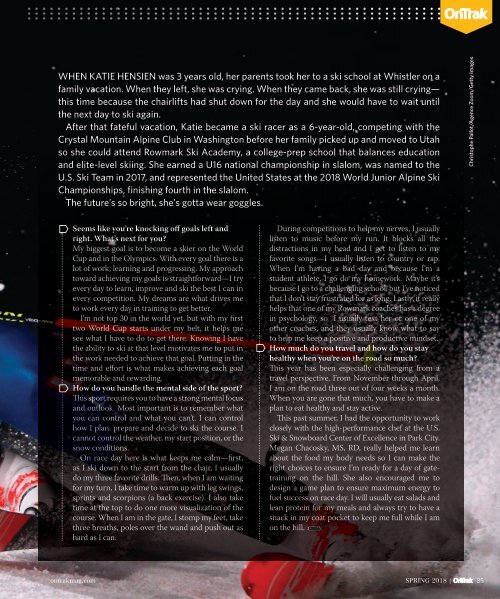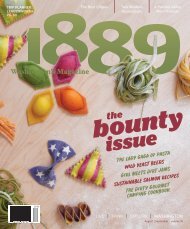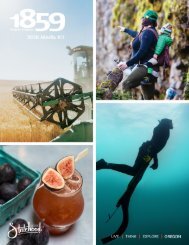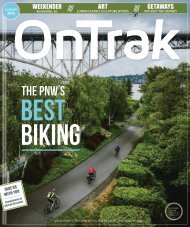Create successful ePaper yourself
Turn your PDF publications into a flip-book with our unique Google optimized e-Paper software.
WHEN KATIE HENSIEN was 3 years old, her parents took her to a ski school at Whistler on a<br />
family vacation. When they left, she was crying. When they came back, she was still crying—<br />
this time because the chairlifts had shut down for the day and she would have to wait until<br />
the next day to ski again.<br />
After that fateful vacation, Katie became a ski racer as a 6-year-old, competing with the<br />
Crystal Mountain Alpine Club in Washington before her family picked up and moved to Utah<br />
so she could attend Rowmark Ski Academy, a college-prep school that balances education<br />
and elite-level skiing. She earned a U16 national championship in slalom, was named to the<br />
U.S. Ski Team in 2017, and represented the United States at the <strong>2018</strong> World Junior Alpine Ski<br />
Championships, finishing fourth in the slalom.<br />
The future’s so bright, she’s gotta wear goggles.<br />
Christophe Pallot/Agence Zoom/Getty Images<br />
Seems like you’re knocking off goals left and<br />
right. What’s next for you?<br />
My biggest goal is to become a skier on the World<br />
Cup and in the Olympics. With every goal there is a<br />
lot of work, learning and progressing. My approach<br />
toward achieving my goals is straightforward—I try<br />
every day to learn, improve and ski the best I can in<br />
every competition. My dreams are what drives me<br />
to work every day in training to get better.<br />
I’m not top 30 in the world yet, but with my first<br />
two World Cup starts under my belt, it helps me<br />
see what I have to do to get there. Knowing I have<br />
the ability to ski at that level motivates me to put in<br />
the work needed to achieve that goal. Putting in the<br />
time and effort is what makes achieving each goal<br />
memorable and rewarding.<br />
How do you handle the mental side of the sport?<br />
This sport requires you to have a strong mental focus<br />
and outlook. Most important is to remember what<br />
you can control and what you can’t. I can control<br />
how I plan, prepare and decide to ski the course. I<br />
cannot control the weather, my start position, or the<br />
snow conditions.<br />
On race day here is what keeps me calm—first,<br />
as I ski down to the start from the chair, I usually<br />
do my three favorite drills. Then, when I am waiting<br />
for my turn, I take time to warm up with leg swings,<br />
sprints and scorpions (a back exercise). I also take<br />
time at the top to do one more visualization of the<br />
course. When I am in the gate, I stomp my feet, take<br />
three breaths, poles over the wand and push out as<br />
hard as I can.<br />
During competitions to help my nerves, I usually<br />
listen to music before my run. It blocks all the<br />
distractions in my head and I get to listen to my<br />
favorite songs—I usually listen to country or rap.<br />
When I’m having a bad day and because I’m a<br />
student athlete, I go do my homework. Maybe it’s<br />
because I go to a challenging school, but I’ve noticed<br />
that I don’t stay frustrated for as long. Lastly, it really<br />
helps that one of my Rowmark coaches has a degree<br />
in psychology, so I usually text her or one of my<br />
other coaches, and they usually know what to say<br />
to help me keep a positive and productive mindset.<br />
How much do you travel and how do you stay<br />
healthy when you’re on the road so much?<br />
This year has been especially challenging from a<br />
travel perspective. From November through April,<br />
I am on the road three out of four weeks a month.<br />
When you are gone that much, you have to make a<br />
plan to eat healthy and stay active.<br />
This past summer, I had the opportunity to work<br />
closely with the high-performance chef at the U.S.<br />
Ski & Snowboard Center of Excellence in Park City.<br />
Megan Chacosky, MS, RD, really helped me learn<br />
about the food my body needs so I can make the<br />
right choices to ensure I’m ready for a day of gatetraining<br />
on the hill. She also encouraged me to<br />
design a game plan to ensure maximum energy to<br />
fuel success on race day. I will usually eat salads and<br />
lean protein for my meals and always try to have a<br />
snack in my coat pocket to keep me full while I am<br />
on the hill.<br />
ontrakmag.com SPRING <strong>2018</strong> | 25

















